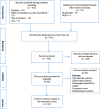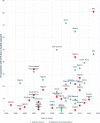Understanding variations in catastrophic health expenditure, its underlying determinants and impoverishment in Sub-Saharan African countries: a scoping review
- PMID: 30205846
- PMCID: PMC6134791
- DOI: 10.1186/s13643-018-0799-1
Understanding variations in catastrophic health expenditure, its underlying determinants and impoverishment in Sub-Saharan African countries: a scoping review
Abstract
Background: To assess the financial burden due to out of pocket (OOP) payments, two mutually exclusive approaches have been used: catastrophic health expenditure (CHE) and impoverishment. Sub-Saharan African (SSA) countries primarily rely on OOP and are thus challenged with providing financial protection to the populations. To understand the variations in CHE and impoverishment in SSA, and the underlying determinants of CHE, a scoping review of the existing evidence was conducted.
Methods: This review is guided by Arksey and O'Malley scoping review framework. A search was conducted in several databases including PubMed, EBSCO (EconLit, PsychoInfo, CINAHL), Web of Science, Jstor and virtual libraries of the World Health Organizations (WHO) and the World Bank. The primary outcome of interest was catastrophic health expenditure/impoverishment, while the secondary outcome was the associated risk factors.
Results: Thirty-four (34) studies that met the inclusion criteria were fully assessed. CHE was higher amongst West African countries and amongst patients receiving treatment for HIV/ART, TB, malaria and chronic illnesses. Risk factors associated with CHE included household economic status, type of health provider, socio-demographic characteristics of household members, type of illness, social insurance schemes, geographical location and household size/composition. The proportion of households that are impoverished has increased over time across countries and also within the countries.
Conclusion: This review demonstrated that CHE/impoverishment is pervasive in SSA, and the magnitude varies across and within countries and over time. Socio-economic factors are seen to drive CHE with the poor being the most affected, and they vary across countries. This calls for intensifying health policies and financing structures in SSA, to provide equitable access to all populations especially the most poor and vulnerable. There is a need to innovate and draw lessons from the 'informal' social networks/schemes as they are reported to be more effective in cushioning the financial burden.
Keywords: Catastrophic health expenditure; Impoverishment; Out of pocket payments; Scoping review; Sub-Saharan Africa.
Conflict of interest statement
Authors’ information
PN is a PhD Fellow/Researcher at the United Nations University–MERIT, School of Governance, Maastricht University, the Netherlands.
Ethics approval and consent to participate
Not applicable.
Consent for publication
Not applicable.
Competing interests
The authors declare that they have no competing interests.
Publisher’s Note
Springer Nature remains neutral with regard to jurisdictional claims in published maps and institutional affiliations.
Figures




Similar articles
-
Catastrophic healthcare expenditure and impoverishment in tropical deltas: evidence from the Mekong Delta region.Int J Equity Health. 2018 Apr 27;17(1):53. doi: 10.1186/s12939-018-0757-5. Int J Equity Health. 2018. PMID: 29703209 Free PMC article.
-
Impact of out of pocket payments on financial risk protection indicators in a setting with no user fees: the case of Mauritius.Int J Equity Health. 2019 May 3;18(1):63. doi: 10.1186/s12939-019-0959-5. Int J Equity Health. 2019. PMID: 31053077 Free PMC article.
-
Assessing the incidence of catastrophic health expenditure and impoverishment from out-of-pocket payments and their determinants in Bangladesh: evidence from the nationwide Household Income and Expenditure Survey 2016.Int Health. 2022 Jan 19;14(1):84-96. doi: 10.1093/inthealth/ihab015. Int Health. 2022. PMID: 33823538 Free PMC article.
-
The Variations in Catastrophic and Impoverishing Health Expenditures, and Its Determinants in Iran: A Scoping Review.Med J Islam Repub Iran. 2023 Apr 26;37:44. doi: 10.47176/mjiri.37.44. eCollection 2023. Med J Islam Repub Iran. 2023. PMID: 37426477 Free PMC article.
-
Financial risk protection from out-of-pocket health spending in low- and middle-income countries: a scoping review of the literature.Health Res Policy Syst. 2022 Jul 29;20(1):83. doi: 10.1186/s12961-022-00886-3. Health Res Policy Syst. 2022. PMID: 35906591 Free PMC article.
Cited by
-
Machine learning based classification of catastrophic health expenditures: a cross-sectional study of Korean low-income households.BMC Health Serv Res. 2025 Aug 7;25(1):1040. doi: 10.1186/s12913-025-13139-0. BMC Health Serv Res. 2025. PMID: 40775329 Free PMC article.
-
Towards the achievement of universal health coverage in the Democratic Republic of Congo: does the Country walk its talk?BMC Health Serv Res. 2022 Jul 4;22(1):860. doi: 10.1186/s12913-022-08228-3. BMC Health Serv Res. 2022. PMID: 35787277 Free PMC article.
-
The microeconomic impact of out-of-pocket medical expenditure on the households of cardiovascular disease patients in general and specialized heart hospitals in Ibadan, Nigeria.PLoS One. 2022 Jul 18;17(7):e0271568. doi: 10.1371/journal.pone.0271568. eCollection 2022. PLoS One. 2022. PMID: 35849602 Free PMC article.
-
Disparities in modern health service utilization across socio-demographic and economic inequalities among households in Gida Ayana district, Oromia Regional state, Ethiopia: a community-based cross-sectional study.BMC Health Serv Res. 2023 Jun 8;23(1):597. doi: 10.1186/s12913-023-09527-z. BMC Health Serv Res. 2023. PMID: 37291621 Free PMC article.
-
Assessing the Determinants of Compliance with Contribution Payments to the National Health Insurance Scheme among Informal Workers in Indonesia.Int J Environ Res Public Health. 2023 Nov 30;20(23):7130. doi: 10.3390/ijerph20237130. Int J Environ Res Public Health. 2023. PMID: 38063558 Free PMC article.
References
-
- J L Murray C, Xu K, Klavus J, Kawabata K, Hanvoravongchai P, Zeramdini R, et al. Assessing the distribution of household financial contributions to the health system: concepts and empirical application. Health systems performance assessment : debates, methods and empiricism. 2003;513–31.
-
- Xu K, Organization WH, et al. Distribution of health payments and catastrophic expenditures methodology. 2005. http://www.who.int/iris/handle/10665/69030. Accessed 28 Sep 2017.
-
- Ezat Wan Puteh S, Almualm Y. Catastrophic health expenditure among developing countries. Health Syst Policy Res. 2017;04 10.21767/2254-9137.100069.
Publication types
MeSH terms
LinkOut - more resources
Full Text Sources
Other Literature Sources
Medical
Molecular Biology Databases
Research Materials
Miscellaneous

